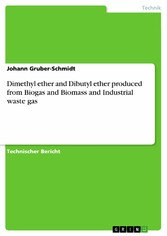Suchen und Finden
Dimethyl ether and Dibutyl ether produced from Biogas and Biomass and Industrial waste gas
Mehr zum Inhalt

Dimethyl ether and Dibutyl ether produced from Biogas and Biomass and Industrial waste gas
Technischer Bericht aus dem Jahr 2018 im Fachbereich Energiewissenschaften, Note: 1, , Veranstaltung: Erneuerbare Treibstoffe, Sprache: Deutsch, Abstract: At the begin of the 20th century C. Weizmann studied methods for substitution of petroleum, the most important fuel at this time beside coal. His famous work led to the patent about the ABE process [1], producing acetone by clostridium acetobutylicum and beside acetone, butanol (C4 alcohol) and ethanol (C2 alcohol) are created. (Historical: acetone could be used in military applications). The ideas [1] were very fruitful, but the world wars and the huge amount crude oil in Texas started a new period of economic development and growth of the world trade and business. At the end of the 20th century we recognized the limitation of the raw materials. Additional the Diesel technology reached a satisfied region in development the pollution of the exhaust gas. 2005 VOLVO started a project replacing fossil Diesel by Dimethyl ether [2]. This was so successful and it was the prolongation of a development done in 2008 by VOLVO [2]. At this time no heavy truck company was interested. At the end of the project VOLVO entered with the DME trucks successful the US market. The next company testing DME was MACK TRUCK followed two years later FORD. This was the birth of a new market. DME has the advantage to be monomolecular fuel, which can be easy supplied to existing and new Diesel engines. Using the known common rail for DME injected into the combustion chamber of engines it changes the phase from liquid to gas. This important property leads to a dramatic reduction of exhaust gas pollution in carbon monoxide, nitrogen oxide and soot, fine particles.
Schule: VS: Schulbrüder 1180 Wien, AHS: Albertus Magnus Gymnasium TU Wien: Maschinenbau / Verfahrenstechnik, Schwerpunkte: Chemische Verfahrenstechnik, Wärme und Stoffaustausch, Energietechnik. ( DI: 1989 ) TU Wien: Nichtlineare dynamische Systeme, Chemisches Engineering. ( Dr. techn. 1993) Berufliche Tätigkeiten: Zeitraum 1994 bis 2000: Begonnen die berufliche praktische Tätigkeit in einer Service-Werkstatt in Wien, und dann zu Wagner Biro GmbH in der Siemensstrasse 89 gewechselt und war dort bis zum 2000 für die Fa. Wagner Biro tätig. Berufliche Tätigkeiten: Zeitraum 2001 bis 2015: Werkverträge, Selbstständig als Gewerbe: in Projekten der Erneuerbaren Energie tätig: Dampfwirbelschicht, Biomasse KWK, Biogas Anlagen, Brenner und Brennkammerbau, Festbettvergaser, Biomethanlage, Reststoffe und DME. Projekte in AT, CZ, SK, HU. Erfahrungen: Praktische und berufliche Erfahrung im Anlagenbau, im speziellen in der Projektierung, Konstruktion, dem Engineering, der Errichtung und dem Bau und dem Betrieb der Anlagen. Pro Jahr werden zwischen 5 bis 10 Patente angemeldet, und Vorträge auf Fachtagungen der Energietechnik, Recycling gehalten. Zudem Erfahrung in Messung, Abnahmemessung und Bewertung von Anlagen (VSI 2048).
Alle Preise verstehen sich inklusive der gesetzlichen MwSt.










